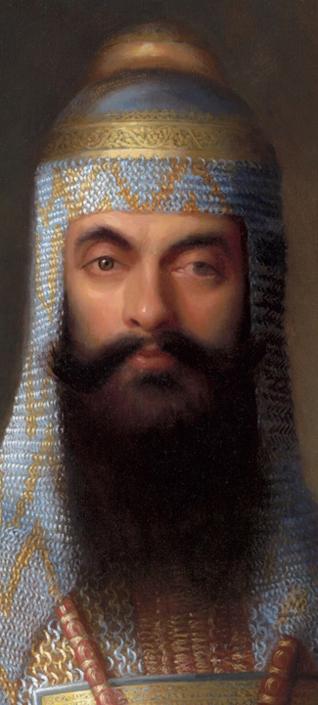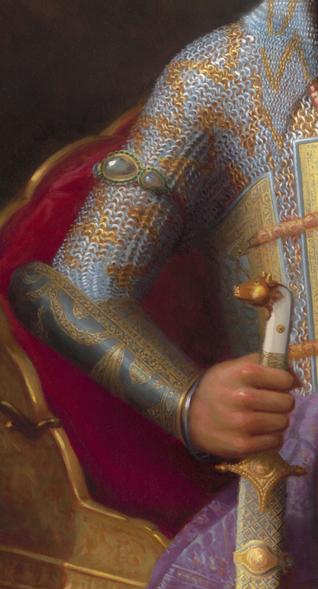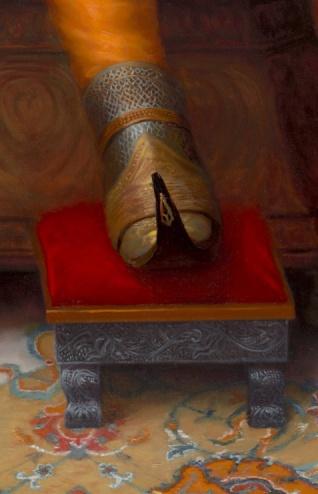Columnists
Manu's Masterpiece
by MICHELE GIBSON
Economies rise and fall over precious things. What becomes desirable creates the supply/ demand pendulum of a market economy.
How is it though that certain things become precious? Diamonds, trees, silk, sunlight, literature and art all derive from different origins yet are all valuable. They are precious by virtue of very different attributes; glitter exploited by careful splitting; oxygen or wood- basic necessities; fabric that is light, colourful, strong and warm; words that penetrate another individual because they mobilize some shared sentiment; and visual images and designs that speak to some deep emotion or value.
The effort to obtain or create things also imbues them with merit. History, origin, religion and sentiment add further distinct worth. So, in the end, a single item can have many different quantities of value.
Such is the painting of Maharaja Ranjit Singh by Manu Kaur Saluja.
A towering masterpiece, already an historical artifact as it is, sits in its full glory in the Ondaatje Gallery of the Royal Ontario Museum in Toronto, Canada.
The painting begins with the tapestry covering the steps to his throne. Telescoping toward the benevolent sovereign, the eye is carried swiftly up the canvas to his face. But then the beauty of the work carries your gaze back to the platform. He is raised just slightly on a brief step the shadow of which dissects your view and provides a natural barrier. Yes, he is gazing down at you. Yes, he is seated on a throne. Yes, he is a king and emperor.
With one foot casually resting on a small stool and the other pointed off to the side, the detail of his simple, yet elegant shoe is displayed. His bright saffron silk pajama is a delight for the eye, rich and penetrating, the colour carries a warm yet joyful energy and sets off the intricate work of the sea blue and gold armor, with a million strokes of her brush she creates the flowing strength and beauty of the chain mail.
He sits atop a throne - now in the possession of the British, and on display at the Victoria and Albert Museum in England. Solid gold with a cushion wrapped in red velvet, he is perched there straight backed, confident and determined, looking every bit as if he is presently hearing your appeal . One arm resting while he concentrates and the other anchored by the handle of his sword - the extraordinary weapon a natural extension of his arm. He is not nestled in the velvet, he is alert, aware, ready, deliberating, considering, carrying out the infinite duties of a sovereign, trustworthy and sympathetic to your concern, to the well-being of his people. The light is direct, illuminating his forward gaze and the even mantle of his shoulders. It is in deep contrast with the subdued lighting that falls on the wall behind in ranges of gold brown to crimson shadows.
It is a room of its own, tempting you to walk toward him and engage him in your cause.
Gaze up and appeal to his face. A sovereign's face, wise and fair, alert and balanced. Ranjit's beard flows dark and full, bordered only by the perfect vertical drape of the heavy chain mail, his hair gathered neatly under his elegant helmut. His aquiline nose set above rose coloured lips- gently pursed in focus to the demands of the day.
This precious painting has many values imbedded in it. Manu's skill, years of research and work, beautiful paints produced from natural sources in rich oils that best suspend the most excellent hues. A labour of love, which must be difficult to part with, I continue to have difficulty parting my gaze from it.
But what is most precious and priceless is that Manu has captured the charectar of the man. A title does not make a king, it is clear now that what makes an emperor is the innate sense of majesty in the man.
Here she has captured his strength and character ... yes, the majesty of Sher-e-Punjab.
The Lion of Punjab.
The original masterpiece can be viewed, alongwith its accompanying life-size portrait of Maharaja Dullep Singh (also by Manu), at The Royal Ontario Museum, Toronto, Canada, until the end of March 2010.
Special Limited Edition prints - on Fine Canvas or Archival Paper - are available at www.ManuSaluja.com
February 19, 2010





